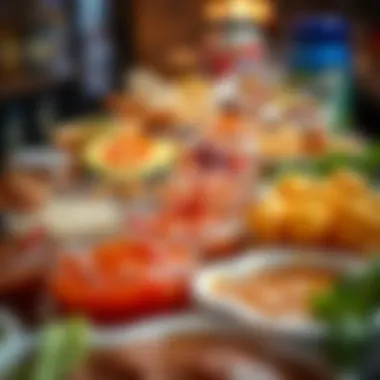Discovering the Finest Shawarma Spots in Jumeirah


Intro
The area of Jumeirah is not just known for its opulent lifestyle, pristine beaches, and iconic landmarks—it also boasts an incredible array of culinary delights. Among these, shawarma holds a special place in the hearts and stomachs of locals and visitors alike. This beloved dish, with its tender, spiced meat wrapped in warm bread, represents more than just a meal; it symbolizes the blend of cultures that flourishes in Dubai.
As you navigate through Jumeirah, it becomes quite evident that shawarma isn't just a fast food option, but rather a culinary experience that can vary greatly from one eatery to another. Here, we dig deeper into what makes the shawarma offerings in Jumeirah unique. From the quality of ingredients used to the rustic methods of preparation and the stories behind each establishment, this article will guide you through the must-try shawarma spots in this vibrant neighborhood.
"Every shawarma tells a story about the culture, the people, and the communities that savor it."
In this search for the best shawarma, we will not only catalog our favorites but also explore the subtle nuances that elevate each bite. Shawarma enthusiasts will appreciate our insights, bolstered by local knowledge and a passion for flavor. This is more than just a food journey; it’s an exploration of Jumeirah's spirit through a wrap of spices and sauces, and we’re here to unfold that tapestry.
Prolusion to Shawarma
Shawarma is not just a dish; it's a culinary experience that encapsulates the essence of Middle Eastern cuisine. Originating from the region centuries ago, it has evolved into a global phenomenon, resonating with diverse cultures and culinary preferences. For expatriates living in Jumeirah or travelers exploring Dubai, shawarma symbolizes more than just convenience; it represents a tapestry of flavors, spices, and traditions all wrapped up in a warm pita or flatbread. Understanding shawarma’s rich background and significance sets the stage for appreciating its variety in Jumeirah.
In this article, we will dive into the historical roots and cultural importance of shawarma to fully appreciate what makes this dish relevant today. When you sit down to indulge in a shawarma, you’re not merely consuming food—you're partaking in a story that traces back to the Levant region, where culinary techniques and flavors were born and refined over generations.
Historical Context
The term “shawarma” comes from the Turkish word "çevirme," meaning "to turn". This refers to the cooking method: meat stacked and slow-cooked on a vertical rotisserie. It is a dish that has traveled through time and geography, reflecting its adaptability to regional tastes. Shawarma's roots can be traced back to the 19th century in the Ottoman Empire, primarily eaten by soldiers and later adopted by civilians looking for hearty, portable meals. It's fascinating to think of shawarma’s journey, reminding us of culinary exchanges that took place through trade, migration, and conquest.
The introduction of shawarma to other parts of the world came with waves of migration and globalization, creating hybrids like the "doner kebab" in Germany and "gyros" in Greece. Nonetheless, authentic shawarma remains a hallmark of Middle Eastern street food, often enjoyed with a side of garlic sauce or tahini. In Jumeirah, the dish has garnered a special place, integrating old-world flavors with modern twists, drawing new generations to its delightful folds.
Cultural Significance in the Middle East
Shawarma isn’t merely sustenance; it serves as a cultural touchstone. Across the Middle East, shawarma is often synonymous with social gatherings, late-night cravings, and street-side conversations. The ritual of grabbing a shawarma after a night out or sharing it during family occasions underscores its importance in daily life. Each bite is layered with memories—first dates, celebrations, or simply unwinding after a long day.
In Jumeirah, the myriad shawarma joints reflect the fusion of traditional and contemporary culinary arts. They offer a warm embrace of flavors that represent the cosmopolitan spirit of the area. The dish has also become something of a cultural ambassador; it brings people together, regardless of background or nationality, inviting them to enjoy a taste of the Middle East.
Overall, understanding shawarma's historical context and its cultural significance helps us appreciate the vibrant shawarma scene in Jumeirah, where each restaurant tells a part of a larger narrative that connects us to our shared culinary heritage.
The Shawarma Craze in Dubai
The culinary scene in Dubai has seen a meteoric rise in popularity for shawarma, making it a staple not just for locals but also for tourists. This craze is rooted in the perfect blend of flavors, convenience, and the social aspect surrounding its consumption. As Jumeirah becomes a melting pot of cultures, shawarma has managed to carve out its niche, embodying the essence of both quick bites and gourmet touches.
Growth of Street Food Culture
Over the past few years, Dubai has witnessed a significant transformation in its street food culture. Once considered the realm of humble eateries, street food has now graduated to being an art form. Vendors showcase skillful preparation, often right in front of patrons, creating an interactive dining experience.
The shawarma stands are emblematic of this growth. They draw long lines of eager customers, all wanting a taste of that juicy wrap adorned with a medley of fresh toppings. It’s no longer just about being inexpensive; the focus is on quality and taste. Consequently, many street vendors are upping their game by sourcing local, fresh ingredients and experimenting with spices, resulting in impressive flavor profiles.
Additionally, this shift has encouraged food festivals that celebrate street food. Events like these not only elevate shawarma's status but also foster a community spirit, with locals and visitors mingling over shared culinary experiences.
Fusion Flavors Influencing Local Shawarma
As Dubai continues to embrace its multicultural identity, shawarma has evolved to include fusion flavors that cater to diverse palates. This blending of culinary traditions results in an exciting array of offerings, where classic shawarma meets unexpected combinations.
For example, some restaurants have integrated regional spices into their marinades, such as za'atar from the Levant or harissa from North Africa, altering the flavor landscape of traditional shawarma. Others are not shying away from integrating global influences, such as teriyaki or Thai chili, creating a delightful twist that surprises even veteran shawarma lovers.
"The taste of shawarma is like a journey through flavors. Each bite tells a story of tradition mingled with innovation."
These innovations don’t disregard the cornerstone of shawarma’s appeal—the tender, flavorful meat roasted to perfection. Instead, they enhance it, making shawarma a canvas for culinary creativity. This leap into fusion dynamics doesn’t just attract adventurous eaters but also plays a pivotal role in the restaurant scene, with businesses constantly vying to impress patrons with something new and bold.
Identifying Quality Shawarma
When it comes to enjoying shawarma, the essence lies in identifying which establishments truly deliver a quality experience. With the vast array of options available in Jumeirah, knowing what to look for becomes crucial for both shawarma aficionados and casual diners. It’s not merely about finding a spot that sells tasty shawarma but discerning the factors that contribute to an unforgettable meal. Quality shawarma is the result of fresh ingredients, thoughtful marinades, cooking techniques, and more—each element plays a significant role in showcasing artistry in culinary form.
Choosing Fresh Ingredients
The foundation of any great shawarma begins with fresh ingredients. Freshness is paramount and can make or break the dish. Meats, vegetables, and sauces need to be top-notch. When you bite into a shawarma wrap, the first sensation should be that of tenderness and flavor, not grit or staleness. Take notice of the sourcing practices of the restaurants. Many businesses have taken to proudly displaying the quality of their meats, often opting for locally-sourced produce and premium cuts of meat.
Look for places where the aroma of marinated meat fills the air. That's a good sign that they prioritize quality. In Jumeirah, some restaurants boast halal-certified meats, ensuring not only quality but also adherence to dietary regulations that are crucial for many diners. Fresh tomatoes, crunchy cucumbers, and fragrant herbs enhance the shawarma, rounding out the experience with a burst of flavor.
The Role of Marinades and Spices
Marinades and spices do wonders for shawarma, turning simple ingredients into masterpieces. The flavors of shawarma come alive through an assortment of spices, from the warmth of cumin to the sharpness of garlic. Each restaurant has its own marinade techniques, and those recipes can be passed down through generations, adding a personal touch.
Often, a combination of yogurt and spices is used to tenderize meat, making it juicier and more flavorful than average. Occasionally, you might even encounter fusion influences in Jumeirah, where traditional marinades meet unexpected flavors, like citrus or local herbs. It’s this blend of the traditional and the innovative that can elevate a meal from ordinary to extraordinary.
"The secret is in the marinade; it’s where the magic begins."
When searching for shawarma, pay attention to the balance of spices. Too much can overwhelm, while too little leaves the dish dull. Knowing how to create a harmonious blend is a true skill, indicative of a chef who understands both the ingredients and the palate of the diner.
Cooking Techniques that Matter


Cooking techniques significantly influence the quality of shawarma. The traditional method often involves slow-roasting vertical spits, allowing the juicy, well-marinated meat to caramelize itself as it turns, yielding an exquisite array of textures. Observing how the meat is cooked can inform you about the restaurant’s commitment to authenticity and quality.
Some establishments might incorporate gas or electric grills, which can produce differing results. While there’s nothing wrong with innovative methods, that primal, smoky flavor associated with traditional shawarma is hard to replicate. The best cooks understand the nuances of high heat combined with slow cooking, letting the shawarma marinate in its own juices—both a labor of love and skill.
In Jumeirah, it's common to see chefs who take their time with each piece, paying attention to every facet—seasoning, marinating, and cooking. Those who prioritize craftsmanship often have customers lining up out the door, eager for a taste of quality shawarma.
In summary, identifying quality shawarma in Jumeirah requires a keen eye for fresh ingredients, a deep appreciation for marinades and spices, and a focus on the cooking techniques employed. These elements collectively determine not just the taste but the entire dining experience, ensuring that every bite is a delightful reminder of what shawarma is supposed to be.
Top Shawarma Spots in Jumeirah
When it comes to shawarma, Jumeirah offers a wide selection that’s sure to please everyone’s palate. The focus here is not just on eating; it is about experiencing the culture and flavors that define shawarma in this area. The top establishments reflect both historical roots and contemporary culinary innovations, making them significant stops for anyone seeking the best.
Established Favorites
These are the tried-and-true spots, where the shawarma is more than just food; it’s a tradition. Here are three noteworthy mentions:
Restaurant One
Located right in the heart of Jumeirah, Restaurant One has built a loyal customer base since it opened its doors. The standout aspect here is their marinated chicken, which is grilled to perfection. The key characteristic that sets this place apart is their signature garlic sauce. It has a rich, creamy texture that complements the meat beautifully.
What makes Restaurant One a beneficial choice in this bustling shawarma scene is the reputation it’s garnered through word of mouth. This isn’t just a place for tourists – locals flock here for their shawarma fix, especially at lunch hours. One unique feature is that you can watch your shawarma being prepared right in front of you, making it feel fresh and personal.
Advantages: Engaging atmosphere and attentive staff.
Disadvantages: It can get quite busy, so patience is key during peak hours.
Restaurant Two
If you’re looking for bold flavors and exceptional quality, Restaurant Two should be on your radar. What truly stands out about this place is their extensive use of fresh, local herbs and spices. This results in a more robust taste, appealing to those who prefer a shawarma with a kick.
Restaurant Two is known for its use of a variety of meats, including lamb and beef, which enhances its appeal to a broad audience. Visitors often describe the shawarma as having a smoky aroma, thanks to their grilling techniques. The crisp, lightly toasted pita adds the perfect crunch.
Advantages: Diverse menu options and a unique flavor profile.
Disadvantages: Slightly higher prices compared to other eateries.
Restaurant Three
For those who appreciate the finer things in life, Restaurant Three is a must-visit. It’s celebrated for its gourmet approach to shawarma. The key characteristic of this place is the high-quality ingredients they source. From organic vegetables to hormone-free meats, this establishment prioritizes health without compromising flavor.
What makes Restaurant Three a popular choice is the upscale setting that invites diners to linger longer. Patrons enjoy more than just food; it’s an experience. They often feature seasonal specials, which changes the game for shawarma enthusiasts looking for something new.
Advantages: Upscale atmosphere with a focus on health.
Disadvantages: Not suitable for quick bites – the dining experience takes longer.
Emerging Contenders
While established favorites hold a strong reputation, new entrants are beginning to make waves in the shawarma scene.
Restaurant Four
Restaurant Four has quickly become a talk among the foodies in Jumeirah. A defining aspect of this restaurant is its embrace of fusion flavors, blending traditional Middle Eastern spices with international culinary techniques. Their shawarma wraps come with inventive fillings like spicy kimchi or avocado.
This adventurous approach makes Restaurant Four a favorable choice, especially among younger diners looking for unique food experiences. The ambiance is also casual, encouraging guests to unwind and enjoy.
Advantages: Innovative takes on classic shawarma.
Disadvantages: Might not resonate with purists who prefer traditional tastes.
Restaurant Five
Bringing a fresh perspective, Restaurant Five prides itself on simplicity and quality. Their shawarmas are a testament to the idea that sometimes less is more. Using fewer, yet carefully selected ingredients allows each flavor to shine through clearly.
What makes Restaurant Five a beneficial choice is their commitment to transparency in sourcing. They publicly share their suppliers, which adds a layer of trust with customers. The cozy setting adds to the allure.
Advantages: Transparency in ingredient sourcing.
Disadvantages: Limited options on the menu for those seeking variety.
The shawarma scene in Jumeirah isn’t just about having a meal; it’s about discovering layers of flavor, culture, and community.
These establishments represent the dynamic range of shawarma experiences available in Jumeirah. Whether you prefer age-old traditions or innovative twists, there is something delightful waiting for everyone.
Customer Experiences and Ratings
The journey of flavor exploration in Jumeirah's shawarma scene cannot be fully appreciated without understanding the profound impact of customer experiences and ratings. In an era where sharing opinions is as easy as a couple of clicks, online reviews have revolutionized the way dining establishments are evaluated. For investors, expatriates, realtors, and entrepreneurs, discerning the nuances of shawarma offerings based on customer feedback becomes imperative, not only for personal dining enjoyment but also for culinary investments or business opportunities.
Customer experiences serve as a form of qualitative data, providing insights that conventional advertising cannot match. When potential diners turn to platforms like Yelp or TripAdvisor, they seek personal anecdotes and detailed evaluations that paint a vivid picture of what awaits them at a restaurant. This is especially true in a multicultural melting pot like Dubai, where taste expectations can vary significantly.
Influence of Online Reviews
Online reviews have become the backbone of restaurant credibility. Often, the first point of contact for a potential customer is a review site. According to a survey, nearly 90% of people trust online reviews as much as personal recommendations.
Reasons to pay attention to online reviews include:


- Diversity of Opinions: Reviews reflect a variety of experiences from different palates, helping to gauge the overall quality of shawarma offerings.
- Insight into Customer Service: Ratings often reveal the level of service and ambiance at a restaurant which can enhance or detract from the overall dining experience.
- Current Practices: Recent reviews indicate whether a restaurant maintains its quality over time or if it has experienced any dips.
The influence of online reviews can sometimes sway the very fate of an eatery. A sudden spike or drop in ratings can lead to fluctuating customer turnout, and understanding this dynamic is crucial for anyone looking to navigate the Jumeirah shawarma landscape effectively.
Personal Testimonials
While online reviews provide a broad overview, personal testimonials offer a glimpse into the emotional and cultural connections people have with specific shawarma spots. These narratives often tell stories beyond just meal descriptions, intertwining personal experiences with the act of sharing a meal. For instance, one might reminisce about evenings spent savoring shawarma with friends, celebrating milestones or simply enjoying a casual night out.
Considerations about personal testimonials include:
- Emotional Resonance: Personal stories often carry emotional weight, influencing choices based on nostalgia or warmth rather than mere taste.
- Community Connection: Testimonials can reflect the soul of the community. Local residents might prefer certain spots not only for their food but also for their ambiance and the sense of belonging they evoke.
- Cultural Insights: Often, the personal experience shared can provide context specific to cultural practices related to shawarma, enhancing the overall understanding of what each restaurant represents in the culinary ecosystem.
"Your dining experience can be a snapshot of cultural interconnectivity, where flavors tell tales and shawarma becomes a canvas illustrating life’s moments."
For those interested in diving deeper into the shawarma scene in Jumeirah, highlighting customer experiences and diving into personal testimonials can illuminate hidden gems and assess the offerings available, making the exploration of this beloved dish a more informed and enjoyable journey.
Comparative Analysis of Shawarma Offerings
In a city as bustling and diverse as Dubai, shawarma is not just a dish; it’s an experience that can vary significantly from one corner of Jumeirah to another. Understanding this comparate analysis, particularly the cost versus quality and the variations in preparation styles, plays a crucial role in both culinary appreciation and informed consumer choice. Through this lens, we explore finer details that truly separate decent shawarma from the exceptional.
Cost Versus Quality Perspective
When it comes to shawarma, the age-old adage often rings true: you get what you pay for. It's tempting to opt for the cheapest option on the menu, especially in a city where street food beckons at every turn. However, investing a little more often translates into a significantly more satisfying gastronomic experience.
Quality shawarma typically relies on fresh ingredients. For instance, locally sourced meats and freshly baked pita elevate the entire dish, making each bite a burst of flavor. One might wonder, is the extra dirham worth it? The answer often lies in the texture and taste.
- Fresh Ingredients: Some establishments are known for their commitment to high-quality produce. For example, sourcing hormone-free chicken can make a noticeable difference in both flavor and health benefits.
- Craftsmanship: The skill of the chef can impact quality, with seasoned pros more adept at marinating and perfectly grilling the meat.
Moreover, premium shawarma spots tend to balance portion size with presentation, ensuring that not only the taste but also the visual appeal of the food hits the mark. Ultimately, when it comes down to it, paying a little extra could mean the difference between a one-off meal and a memorable feast.
Variations in Preparation Styles
Preparation styles of shawarma can differ quite a bit, even within the same neighborhood. One can find variations ranging from the traditional spinning rotisserie method to modern adaptations that feature innovative techniques. Each restaurant's approach adds its own character to the dish.
For example, consider the difference between:
- Traditional Spinning and Grilling: In many places, meats are not just left on a vertical spit but are marinated in a multitude of spices, resulting in deeply flavored shawarma that practically melts in your mouth.
- Innovative Techniques: On the flip side, some joints experiment with fusion techniques—think shawarma tacos or shawarma burritos—paying homage to different culinary traditions while still holding on to its roots.
Also noteworthy is how some chefs play with the cooking times and temperatures, which can significantly affect the meat's tenderness and flavor profile. As a consumer, knowing these variations can guide your choices, helping you find just the right place that aligns with your tastes and preferences.
The shawarma experience in Jumeirah is as much about the preparation and quality as it is about the cost. Understanding these elements will not only enrich your palate but also enhance your culinary journey.
Seasonal Influences on Shawarma Menus
Shawarma has long been a staple in the Middle Eastern culinary scene, but the dynamic environment of Jumeirah has influenced how this favorite is represented on menus. As seasons change, so do the offerings, not just in terms of ingredients, but also in concepts and creativity. Understanding these seasonal influences sheds light on how various restaurants adapt their shawarma dishes to enhance flavors, cater to preferences, and surprise loyal customers.
Seasonal Ingredients Utilization
When one talks about food, fresh ingredients are the true game changers. The peak of summer brings fresh vegetables like tomatoes, cucumbers, and greens, while winter might see heartier root vegetables making their way into shawarma wraps or sides. This emphasis on fresh, seasonal produce helps restaurants maintain quality.
- Summer: Think vibrant tomatoes and refreshing cucumbers found in salads served alongside shawarma. With the heat, cool, creamy tahini sauces are more popular as they provide a pleasing contrast.
- Winter: Root vegetables, like sweet potatoes, get incorporated into spicy shawarmas, creating a warm, comforting feel.
Using seasonal ingredients not only aligns with a sustainable food sourcing approach but also resonates with local consumers who appreciate flavors that reflect their surroundings. A shawarma restaurant that embraces seasonality can differentiate itself, drawing in the health-conscious demographic who favor fresh and organic choices.
Special Shawarma Promotions and Events
Every season typically brings its own festivals and events that can influence shawarma menus. These occasions are often perfect for restaurants to introduce limited-time offerings or promotions that connect with cultural festivities.
For instance, during Ramadan, culinary creativity is at its peak. Many shawarma places offer Iftar specials - unique shawarma wraps filled with traditional ingredients, catering to the collective spirit of breaking fast. Customizing shawarma with ingredients that hold cultural significance amplifies its appeal.
- Eid Celebrations: Around Eid, restaurants might launch extravagantly garnished shawarmas, adorned with pistachios or dried fruits, making them not just a meal but a festive experience.
- National Holidays: During public holidays, discounts may draw in crowds, and limited edition flavors take center stage.
Special promotions keep the shawarma experience fresh and exciting. Besides driving foot traffic to establishments, these creative campaigns encourage diners to indulge in flavors they might not have tried otherwise, promoting exploration and culinary adventurism.
“Seasonality in shawarma not only showcases the freshness of ingredients but also the creativity of chefs responding to the culinary calendar.”
Nutritional Aspects of Shawarma
Understanding the nutritional implications of shawarma helps consumers make informed choices while enjoying this popular dish. Shawarma is much more than just a tasty bite; it can provide a variety of essential nutrients depending on its ingredients and how it’s prepared. For an audience looking for both flavor and health insights, recognizing these aspects is crucial. After all, knowing what goes into your food can change the way you perceive street eats and takeaway favorites.
Caloric Content and Ingredients
Shawarma typically contains several key ingredients: seasoned meat, vegetables, sauces, and pita bread or wrap. The caloric content of your shawarma can vary widely based on these components. For instance, a serving of grilled chicken shawarma wrapped in pita could range from 300 to 600 calories.
Here’s a breakdown to consider:


- Meat Type: Chicken, beef, or lamb influence the calorie count immensely. Chicken is generally leaner, thus often lower in calories compared to lamb.
- Sauces: Garlic sauce or tahini adds richness but also calories. One tablespoon can add approximately 90 calories.
- Pita vs. Rice: Wrapping it in pita offers convenience, but opting for a plate served with rice could boost your caloric intake slightly.
If you're watching your waistline, keep an eye out for portion sizes and consider skipping heavy sauces or opting for a light drizzle instead. A balanced shawarma choice can provide protein and fiber, which are necessary for energy and digestion.
Healthier Shawarma Alternatives
While traditional shawarma is delightful, there are healthier options worth exploring.
- Whole Grain Frwraps: Using whole wheat wraps instead of white pita not only lowers the glycemic index but also ups the fiber content.
- Grilled vs. Fried: Grilled meat reduces unhealthy fats. Some places may offer fried versions, which significantly increase calorie count.
- Add Extra Veggies: Loading your shawarma with extra veggies can boost its nutritional value significantly. Consider opting for lettuce, tomatoes, and cucumbers to add volume without excessive calories.
- Choose Lean Proteins: Seek out establishments that offer options like turkey shawarma or vegetarian versions made with falafel or grilled vegetables.
"By being mindful of the ingredients and preparation methods, you can savor the rich flavors of shawarma while keeping your health in check."
Embracing these healthier alternative choices can make shawarma an enjoyable dish without the guilt. As a culinary practice, it's evolving; it’s not just about flavor but also about fitting into a vibrant lifestyle that values health and taste.
Shawarma and Jumeirah's Culinary Scene
The culinary scene in Jumeirah is as diverse as it is flavorful, with shawarma carving out a niche that resonates deeply across many cultural perspectives. Shawarma is more than just a dish; it embodies the melding of traditions and tastes that Dubai, and especially Jumeirah, excels at. Finding the best shawarma involves delving into this intricate relationship between local palates and global influences, making it a crucial focal point for both residents and visitors.
Integration with Local Taste Buds
When it comes to integrating with local flavors, shawarma stands out as a prime example. Its adaptability has allowed it to blend seamlessly with the local ingredients and cooking methods that define Jumeirah’s rich culinary landscape. For instance, while traditional shawarma often features beef, lamb, or chicken, Jumeirah's version might incorporate unique spices and marinades that resonate with Emirati gastronomy. Ingredients like za'atar and saffron may find their way into shawarma recipes here, providing that extra layer of depth that locals crave.
In this vibrant area, the street vendors and high-end restaurants alike recognize the significance of local ingredients. A shawarma joint might source its meats from nearby farms, and its vegetables might come fresh from local markets. This not only guarantees quality but also resonates with the ethos of supporting local businesses.
"In Jumeirah, shawarma is not just food; it’s a representation of cultural diversity that tantalizes the palate and warms the heart."
The fusion with local flavors means that shawarma offers something unique—a taste of Jumeirah that one cannot find elsewhere. This interplay fosters a culinary pride, where every bite tells a story of the land and its people, creating a memorable experience for food lovers.
Shawarma's Role in Social Gatherings
Shawarma plays an essential role in the social fabric of Jumeirah. It is not just a meal; it’s a communal experience that brings people together. Whether grabbing a quick bite after work or indulging in a late-night feast with friends, shawarma is the go-to option for many. It embodies the spirit of sharing, where families and friends enjoy flavorful wraps and burgers over lively conversations.
The accessibility of shawarma, both in terms of price and location, makes it a favorite among all demographics—students, expatriates, and families alike. Events like community gatherings or celebrations often feature shawarma as a staple, further solidifying its status as a social food. Restaurants often create family-style platters or offer a variety of sauces and toppings, encouraging diners to customize their shawarma experience to their liking, thus promoting interaction.
In essence, shawarma in Jumeirah has transcended mere sustenance. It is interwoven into the cultural and social happenings of the area, embodying the very essence of community spirit. The experience of enjoying shawarma together brings warmth, laughter, and a sense of belonging, making it all the more cherished in the culinary scene of Jumeirah.
Future Trends in Shawarma Preparation
The evolution of shawarma in Jumeirah is not merely a passing phase; it’s a glimpse into the future of culinary art. As the demand for unique flavors and sustainable practices grows, shawarma enthusiasts are witnessing a transformation in how this iconic dish is being prepared and served. The trends today emphasize not just the taste but also the story behind each bite. Focusing on innovations in flavor profiles and utilizing technology to hone cooking methods are elements that are shaping modern shawarma.
Innovation in Flavor Profiles
Shawarma’s flavor has always been a blend of spices and marinades, but innovation is taking this fusion to new heights. Local chefs experiment with global influences, adding unexpected elements to traditional recipes. For instance, they might incorporate Asian spices such as kimchi or use garlic from Mediterranean influence to enhance the richness of the meat. Imagine tasting a shawarma wrapped with spicy mango chutney and topped with pickled vegetables—an audacious mash-up that celebrates both local culture and global flair.
The potential for new flavors doesn’t only lie in sauces; it extends to the type of meat as well. While chicken and lamb have long been the stars of shawarma, vegan and plant-based options are becoming increasingly popular. Shawarma made from jackfruit or marinated portobello mushrooms offers a robust flavor profile that caters to the health-conscious and environmentally aware consumer. Keeping your taste buds guessing while sticking to your personal dietary choices can redefine what shawarma means to many.
"The future of shawarma lies in its ability to adapt and innovate, creating an experience that surprises and delights with every bite."
Technological Advancements in Cooking
In the past, shawarma was primarily the art of skilled chefs who relied on traditional cooking methods. Today, technology is changing the game in Jumeirah's shawarma joints. Vertical broilers that maintain consistent temperature are gradually becoming standard, ensuring meats are cooked evenly and retain juiciness. Advanced sensors and timers will help avoid overcooking, which could lead to dry textures.
Another exciting development is the integration of smart kitchens. Many establishments are beginning to adopt IoT (Internet of Things) technology for real-time monitoring of inventory and ingredient freshness. This ensures that only the best and most flavor-packed ingredients are used. Imagine walking into your favorite shawarma place and seeing robots preparing your meal—while still in touch with traditional cooking methods for a dash of authenticity.
Furthermore, mobile apps are facilitating a new way of serving shawarma. Customers can now order ahead, customizing their wraps down to the last detail with just a few taps on their smartphones. This shift not only enhances customer experience but also reduces wait times, creating a smoother culinary adventure.
In summary, the future of shawarma in Jumeirah is a melange of creativity and technology. As we evolve our taste profiles and adopt innovative cooking methods, the humble shawarma remains a means of connecting cultures while paving the way to a newer, gustative frontier.
End
The journey through Jumeirah's shawarma scene offers more than just a taste of delicious food; it reveals the intricate relationships between culture, community, and culinary craft. The shawarma, a beloved street food, encapsulates a rich heritage that intertwines with modern influences, reflecting the diverse population of Dubai. Understanding this aspect is vital for anyone interested in the local food landscape or considering investments in the area's gastronomical ventures.
Summarizing Jumeirah's Shawarma Landscape
Jumeirah is not merely home to shawarma; it is a dynamic hub where traditional flavors meet contemporary tastes. The shawarma offerings here are a melting pot of influences. You can find everything from the classic spiced meats wrapped in soft pita, to innovative interpretations that mix local spices with global flavors. This diversity captures the essence of Jumeirah's culinary identity.
Locations like Restaurant One solidify their standing with a tried-and-true approach, while places such as Restaurant Four introduce surprising elements that entice the palates of both residents and tourists. As a testament to its cultural significance, shawarma in Jumeirah speaks to the community's embrace of varied culinary traditions and their ongoing evolution.
Recommendations for Shawarma Enthusiasts
For those keen on experiencing the best of Jumeirah's shawarma, checking out a mix of established favorites and emerging contenders is advisable. Start with renowned spots like Restaurant One, celebrated for its authentic flavors. If you fancy venturing off the beaten path, Restaurant Five could surprise you with its innovative takes on the classic dish.
When sampling shawarma, consider the following tips:
- Pay Attention to Ingredients: Fresh meats and local spices can make a world of difference in flavor. Always inquire about the origins of the ingredients.
- Explore Different Styles: Different establishments often have unique marinades and cooking methods. Don’t hesitate to try a variety to find your personal favorite.
- Seek Out Seasonal Specials: Some restaurants offer rotating specials that showcase seasonal ingredients, adding richness to the experience.
In summary, whether you're a long-time resident or a first-time visitor to Jumeirah, the world of shawarma here is rich, varied, and ever-evolving. Your culinary adventure awaits, and exploring these flavors may even open doors to understanding the vibrant culture that pulses through Jumeirah.
"Food is our common ground, a universal experience." — James Beard
For more information on shawarma and its cultural significance, consider visiting resources like Wikipedia or Britannica. You can also find vibrant discussions and recommendations on platforms like Reddit which could further guide your exploration.



